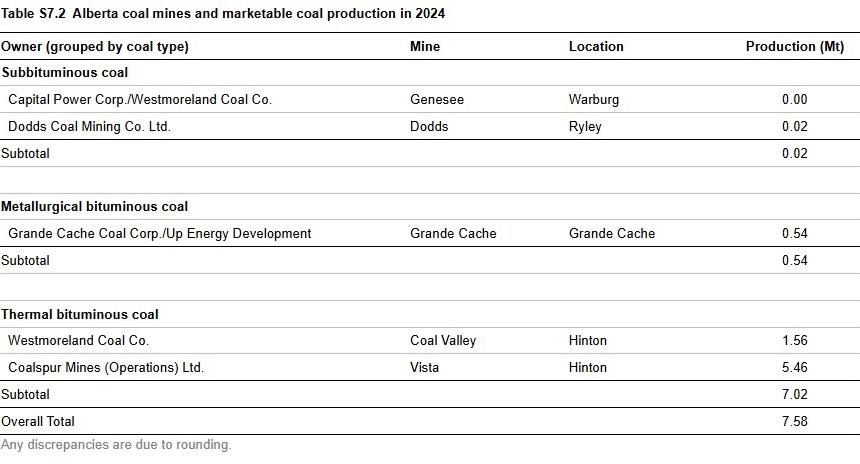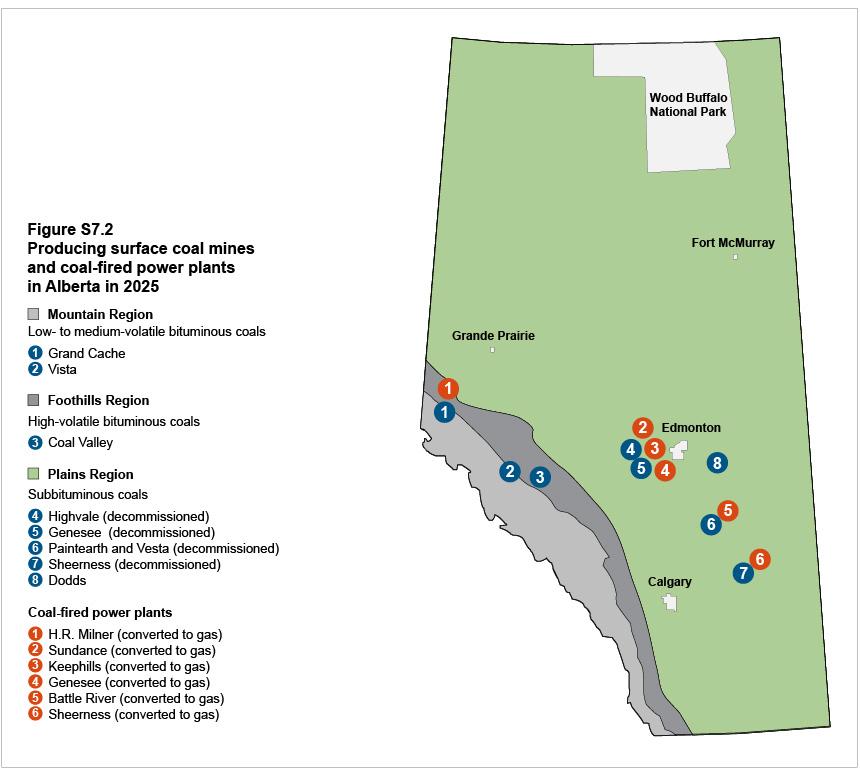Updated June 2025
Summary
In 2024, total production of marketable coal decreased by 32% from 2023. As shown in Figure S7.1, subbituminous coal production was near zero in June 2024 with the decommissioning of the Genesee mine and the full conversion of the Capital Power Genesee generating station (the last coal-fired power plant in Alberta) to natural gas. Thermal and metallurgical bituminous coal will comprise most of Alberta’s future total marketable coal production.

Of the marketable coal produced in 2024,
- 0.3% was subbituminous,
- 92.6% was thermal bituminous, and
- 7.1% was metallurgical bituminous.
Subbituminous Coal
In 2024
Subbituminous coal production in Alberta accounts for 0.3% of the total marketable coal production in 2024. Production of subbituminous coal decreased by 99% in 2024 to 0.02 megatonnes (Mt). Coal production from the Genesee mine ended as the mine was decommissioned in June 2024, coinciding with the full conversion of the Capital Power Genesee generating station to natural gas. The use of coal to generate electricity has been phased out in Alberta several years ahead of the legislated 2030 deadline.
Forecast for 2025 to 2034
With the June 2024 closure of the Genesee mine, subbituminous coal production is expected to be near zero, with some production from the Dodds coal mine, which supplies coal for heating agricultural, residential, and industrial buildings throughout Western Canada. Rising carbon costs, reducing emissions, and a commitment to use more renewables were significant factors in Alberta’s transition away from coal-fired power generation.
Metallurgical Bituminous Coal
In 2024
Production of marketable metallurgical bituminous coal (called coking coal) decreased by 24% in 2024 compared with 2023 to 0.54 Mt due to lower coal prices.
Thermal Bituminous Coal
In 2024
Production of marketable thermal bituminous coal (called steaming coal) was down from 7.4 Mt to 7.0 Mt in 2024, a decrease of 6%.
Forecast for 2025 to 2034
In 2023, the Supreme Court of Canada ruled the designated projects section in the federal Impact Assessment Act, also known as Bill C-69, as unconstitutional. As a result, some coal companies have submitted applications for coal development in Alberta. In particular, the Mine 14 and the Vista Coal Mine Phase II Expansion coal projects will be allowed to undergo regulatory review because they were exempt from a provincial ministerial order banning coal development in the Rockies. In addition, in January 2025, the Alberta Government lifted a ban on coal exploration in the Eastern Slopes of the Rocky Mountains for projects with existing exploration permits. Therefore, we have included these two projects in our production forecast but have applied a risk factor to account for the regulatory approvals process. The projection for bituminous coal production will grow slightly throughout the forecast.
In December 2024, the Government of Alberta announced they would engage with the coal industry to develop a new comprehensive coal policy, the Alberta Coal Industry Modernization Initiative. The initiative will focus on water protection, including best practices to prevent selenium from entering waterways, no open-pit mining in the Foothills (Eastern Slopes), and prohibit mountaintop removal coal mining. The initiative will ensure responsible coal development and encourage new investment and job creation for Albertans.
Table S7.2 lists the coal mines in Alberta and their marketable production in 2024.

Figure S7.2 shows Alberta’s coal mines and coal-fired power plants that were decommissioned or converted to natural gas.



